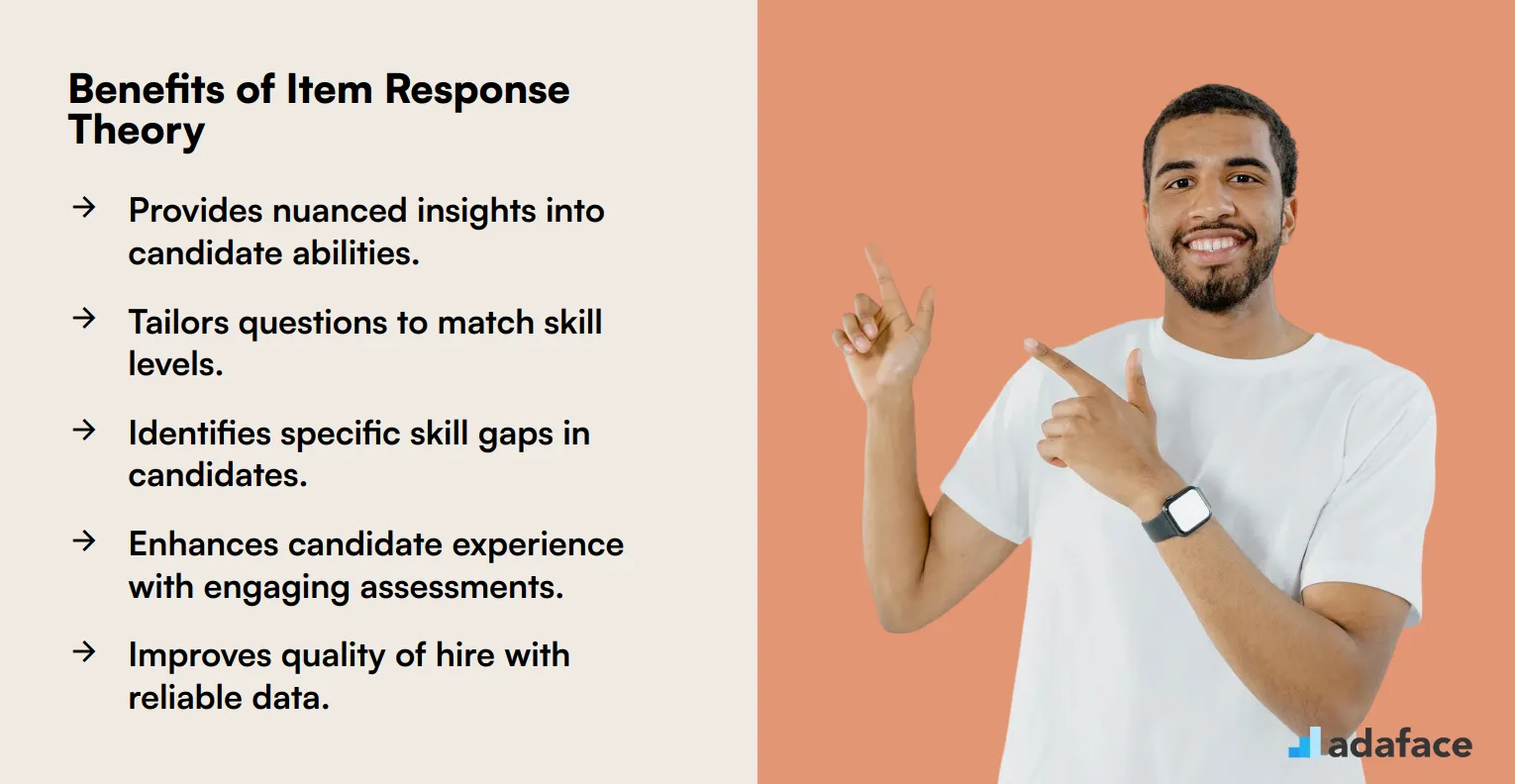Ever wondered how to make your candidate assessments more precise? Item Response Theory (IRT) offers a statistically sound approach to evaluating candidate skills and traits, going beyond simple scoring.
Think of IRT as a way to understand not just if someone got a question right, but why. This understanding helps you make better hiring decisions.
Table of contents
What is Item Response Theory?
Item Response Theory (IRT) is a statistical approach used in psychometrics to analyze and design tests. It models the relationship between an individual's ability or trait and their responses to test items, providing a more nuanced understanding of test performance than traditional methods.
Unlike classical test theory, which focuses on overall test scores, IRT examines each item's characteristics individually. This allows for a more detailed analysis of how different questions contribute to measuring the underlying trait or ability being assessed.
One of the key advantages of IRT is its ability to create adaptive tests that adjust difficulty based on the test-taker's responses. This results in more efficient and accurate assessments, as each person receives questions tailored to their skill level.
IRT also provides valuable insights into item bias and test fairness. By analyzing how different groups perform on specific items, it helps identify questions that may be unfairly advantaging or disadvantaging certain demographics.
In the context of recruitment and HR, IRT can significantly improve the quality and effectiveness of pre-employment assessments. It enables the creation of more reliable and valid tests, leading to better hiring decisions and a more diverse candidate pool.
Key concepts in Item Response Theory
Item Response Theory (IRT) is a framework used to design, analyze, and score tests, questionnaires, and similar instruments measuring abilities, attitudes, or other variables. It offers a mathematical model that predicts the probability of a given response to an item based on the respondent's latent trait level.
One key concept in IRT is the latent trait, which represents an unobservable characteristic or attribute that IRT aims to measure. This trait is often something like ability or proficiency in a particular domain, and it influences how individuals respond to test items.
Another important component is the item characteristic curve (ICC), which graphically represents the relationship between the latent trait and the probability of a correct response. The ICC helps in understanding how different items function across varying levels of the latent trait.
The difficulty parameter is crucial in determining how challenging an item is for respondents. A higher difficulty parameter indicates that only individuals with a higher level of the latent trait are likely to answer the item correctly.
The discrimination parameter measures how well an item can differentiate between individuals with different levels of the latent trait. High discrimination means the item is effective at distinguishing between respondents who are above or below a certain trait level.
Lastly, the guessing parameter accounts for the probability of a correct response due to guessing, particularly in multiple-choice formats. This parameter is essential for accurately modeling the probability of correct responses when guessing is a factor.
How IRT helps in recruitment
Item Response Theory (IRT) offers a powerful framework for enhancing recruitment processes by providing nuanced insights into candidate abilities. It allows recruiters to move beyond traditional assessments, offering a more tailored evaluation of candidate skills and potential.
One of the key advantages of IRT in recruitment is its ability to adaptively assess candidates. By tailoring questions based on previous responses, it ensures a more accurate measurement of a candidate's abilities, reducing the likelihood of misjudging their potential.
IRT also aids in identifying specific skill gaps in candidates, allowing recruiters to focus on areas that need improvement. This targeted approach helps in making informed decisions, ensuring that the right talent is selected for the right roles.
Furthermore, IRT can enhance the candidate experience by offering a more engaging and less stressful assessment process. Candidates are less likely to feel overwhelmed, leading to a more positive perception of the recruitment process.
Incorporating IRT into recruitment strategies can significantly improve the quality of hire by providing a deeper understanding of candidate capabilities. This makes it an invaluable tool for recruiters aiming to build high-performing teams.

Applying IRT to candidate assessment
Applying Item Response Theory (IRT) to candidate assessment can significantly improve the hiring process. It helps in creating more precise and reliable evaluations of a candidate's skills and abilities.
IRT allows for adaptive testing, where the difficulty of questions adjusts based on the candidate's performance. This means that if a candidate answers a question correctly, the next question will be more challenging, and vice versa. This adaptive approach ensures that each candidate is evaluated at their appropriate skill level, providing a more accurate assessment than traditional fixed-length tests.
Furthermore, IRT provides detailed information about each question's difficulty and its ability to discriminate between candidates with different skill levels. This data helps in refining the assessment questions, ensuring they are relevant and effective in measuring the desired competencies. This can be especially useful when looking at candidate experience during the interview process.
By using IRT, recruiters can better understand a candidate's true skill level and make more informed hiring decisions. This leads to better job fit and reduced turnover, ultimately saving time and resources for the organization. Ultimately, this can help you build a better talent pipeline.
Challenges and limitations of IRT in hiring
While Item Response Theory (IRT) offers a nuanced approach to evaluating candidate responses, it faces challenges in the hiring context. One limitation is the complexity of developing and maintaining IRT-based assessments, which can be resource-intensive for HR teams.
IRT assumes that the characteristics of the test items remain constant across different populations, which might not always hold true in diverse hiring scenarios. This can lead to potential biases if not carefully managed, affecting the fairness of the assessment process.
Another challenge is the need for a large sample size to accurately calibrate the test items, which might not be feasible for smaller organizations or niche roles. This requirement can limit the applicability of IRT in scenarios where the candidate pool is limited.
Additionally, the interpretability of IRT results can be a hurdle for recruiters who are not well-versed in psychometrics. This can lead to misinterpretation of candidate abilities, impacting the overall hiring decision.
Despite these challenges, IRT remains a valuable tool when used with caution and expertise, especially in conjunction with other assessment methods. Understanding its limitations allows HR professionals to better tailor their recruitment strategies and ensure a fair evaluation process.
Tools and software for IRT analysis
When it comes to Item Response Theory (IRT) analysis, having the right tools and software is crucial for recruiters and hiring managers. These tools help in evaluating candidate responses and ensuring that assessments are both reliable and valid.
Several software options are available for IRT analysis, each with its own unique features. Some popular choices include R packages like 'ltm' and 'TAM', which are favored for their flexibility and comprehensive statistical capabilities.
For those who prefer a more user-friendly interface, commercial software like Xcalibre and IRTPRO offer intuitive platforms. These tools are designed to make the process of IRT analysis accessible even to those without a deep statistical background.
Incorporating IRT tools into your recruitment process can significantly enhance the accuracy of assessments. This ensures that you are making informed hiring decisions based on reliable data.
Leveraging these tools can also aid in identifying the importance of soft skills in the workplace. This helps in creating a more holistic view of a candidate's potential fit within your organization.
Item Response Theory FAQs
Traditional scoring simply counts correct answers. IRT analyzes the difficulty and discrimination of each question, providing a more nuanced understanding of a candidate's ability.
IRT offers several advantages, including more accurate candidate assessment, reduced bias, and the ability to tailor assessments to specific job requirements. It also helps to improve candidate experience.
While the underlying theory can be complex, several tools and software packages simplify the implementation of IRT for recruitment. These tools provide user-friendly interfaces and automated analysis.
IRT is particularly well-suited for assessments that measure specific skills or knowledge domains. It can be applied to cognitive tests, personality assessments, and other types of pre-employment testing.
Start by researching available IRT software and tools. Consider consulting with a psychometrician or assessment expert to help you design and implement IRT-based assessments.
Avoid using IRT without a solid understanding of the underlying statistical principles. Also, ensure that your assessments are properly calibrated and validated to ensure accurate results.

40 min skill tests.
No trick questions.
Accurate shortlisting.
We make it easy for you to find the best candidates in your pipeline with a 40 min skills test.
Try for freeRelated terms



